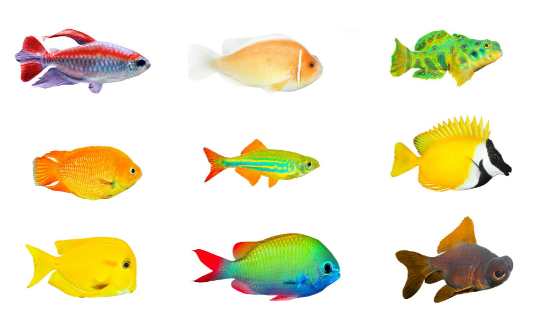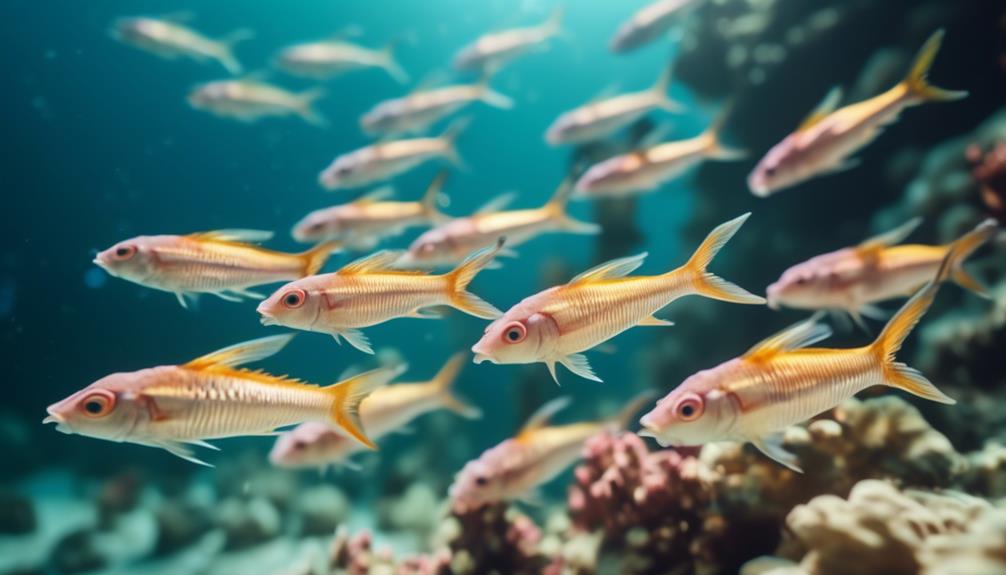
Are you ready to explore the captivating world of goatfish? Prepare to be amazed as you uncover the intriguing behavior, breeding habits, and more of these unique creatures.
As you dive into this fascinating topic, you’ll discover their preferred habitat and schooling behavior, creating a mesmerizing display underwater.
But that’s just the beginning. There’s so much more to learn about their feeding habits, water conditions, and even their breeding process.
So, let’s dive in and unravel the secrets of these remarkable fish that will leave you wanting to know more.
Key Takeaways
- Goatfish are bottom-swimming and non-aggressive fish that prefer to swim in groups and appreciate live rock and hiding places.
- They are found in temperate, subtropical, and tropical waters, with some species inhabiting coral reefs.
- Goatfish prefer slightly alkaline water with moderate hardness, but they can tolerate a variety of water conditions with regular testing and adjustments.
- Their diet consists of sifting through sandy substrate and feeding on small crustaceans, worms, insects, and small fish. It is important to replicate their natural diet in captivity by offering a variety of fresh and frozen meaty foods.
Goatfish Aquarium Care
When caring for goatfish in an aquarium, it’s important to consider their specific needs and requirements.
First and foremost, you’ll need a medium to large-sized aquarium to accommodate these fish properly. They also require weekly care, making sure to maintain suitable water conditions.
Goatfish thrive in saltwater tanks, but it’s crucial not to keep them with very small fish that they might see as potential prey. In terms of behavior and habitat, goatfish are bottom-swimming fish that are generally non-aggressive. They can be found in temperate, subtropical, and tropical waters, with some species even inhabiting coral reefs.
Most goatfish species are schooling fish, so it’s best to keep them in groups. Overall, providing them with moderate hardness and slightly alkaline pH water, along with a variety of fresh and frozen meaty foods for their benthic feeding habits, will help ensure their well-being in your aquarium.
Goatfish Behavior and Habitat
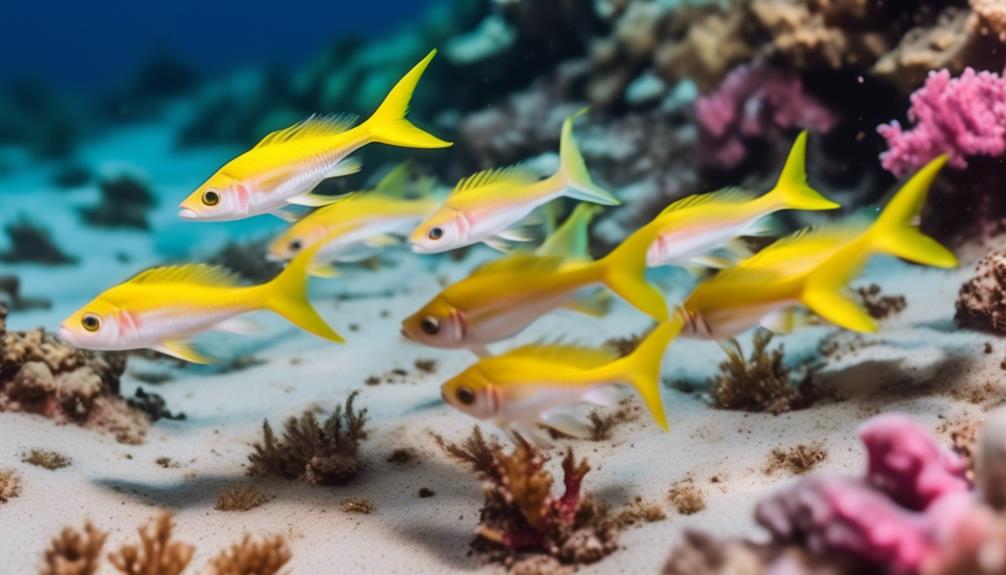
Goatfish exhibit bottom-swimming behavior and are generally non-aggressive, making them suitable for a variety of aquatic habitats. They can be found in temperate, subtropical, and tropical waters, with some species inhabiting coral reefs.
Most goatfish are schooling fish, preferring to swim in groups. They thrive in temperate to tropical water with moderate hardness and slightly alkaline pH levels. However, they can tolerate a variety of water conditions. Goatfish appreciate the presence of live rock and hiding places in their habitat.
Their feeding habits involve sifting through sandy substrates to consume small crustaceans, worms, insects, and even small fish. To properly care for goatfish in an aquarium, it’s important to provide them with a medium to large-sized tank and offer a variety of fresh and frozen meaty foods.
Goatfish Water Conditions
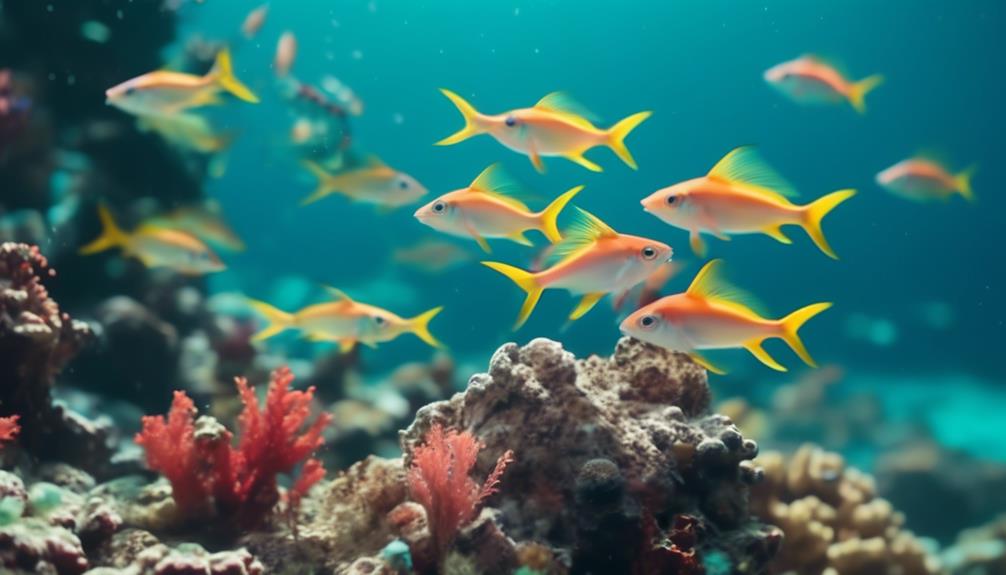
To ensure the optimal conditions for goatfish, it’s important to provide a slightly alkaline pH and moderate hardness in their water environment. Goatfish prefer temperate to tropical water and can tolerate a variety of conditions. However, they appreciate water that’s slightly alkaline with moderate hardness. This can be achieved by testing the water regularly and making necessary adjustments.
It’s also beneficial to provide live rock and hiding places in the aquarium, as goatfish are bottom-swimming fish that appreciate places to explore and take cover. By creating the right water conditions, you can help your goatfish thrive and exhibit their natural behaviors in the aquarium.
Goatfish Feeding Habits
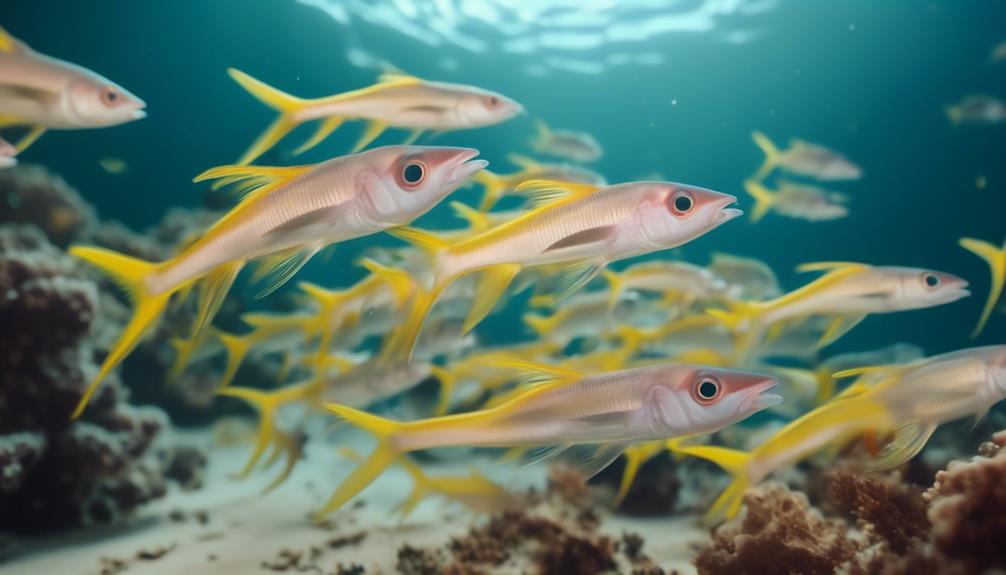
To properly provide for the feeding needs of your goatfish, it is essential to understand their dietary habits and preferences. Goatfish are benthic feeders that sift through sandy substrate in search of food. They primarily feed on small crustaceans, worms, and insects, but they also consume small fish. To replicate their natural diet in captivity, offer a variety of fresh and frozen meaty foods such as brine shrimp, mysis shrimp, and chopped seafood. Additionally, sinking carnivore pellets and granules can be given to ensure a well-balanced diet. To give you a clearer picture, here is a table summarizing the feeding habits of goatfish:
| Feeding Habits |
|---|
| Benthic feeders |
| Feed on small crustaceans, worms, and insects |
| Also consume small fish |
| Offer a variety of fresh and frozen meaty foods |
| Sinking carnivore pellets and granules can be given |
Goatfish Breeding Information
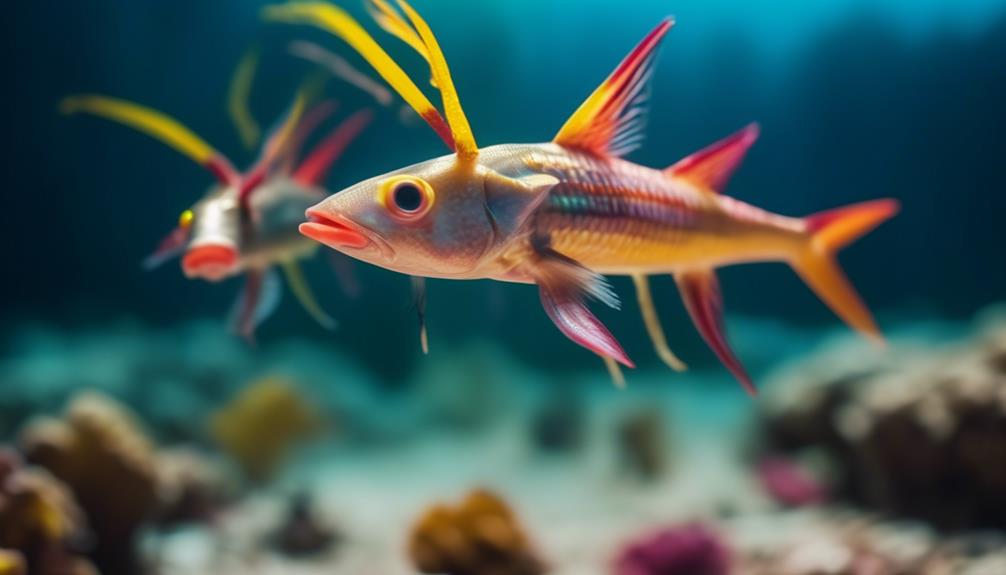
When breeding goatfish, it’s important to understand their reproductive behavior and the process of egg release. Here are some key points to consider:
- Most species are pelagic spawners, releasing buoyant eggs into the water.
- The eggs float freely with the current until they hatch.
- Larvae develop over a period of 4 to 8 weeks.
- After metamorphosis, they develop barbels that are used for bottom feeding.
Breeding goatfish requires providing suitable conditions for the eggs to develop and ensuring a healthy environment for the larvae to grow.
Understanding the reproductive behavior and egg release process of goatfish is crucial for successful breeding. By creating the right conditions and providing proper care, you can contribute to the conservation and study of these fascinating fish.
Suitable Tank Size for Goatfish
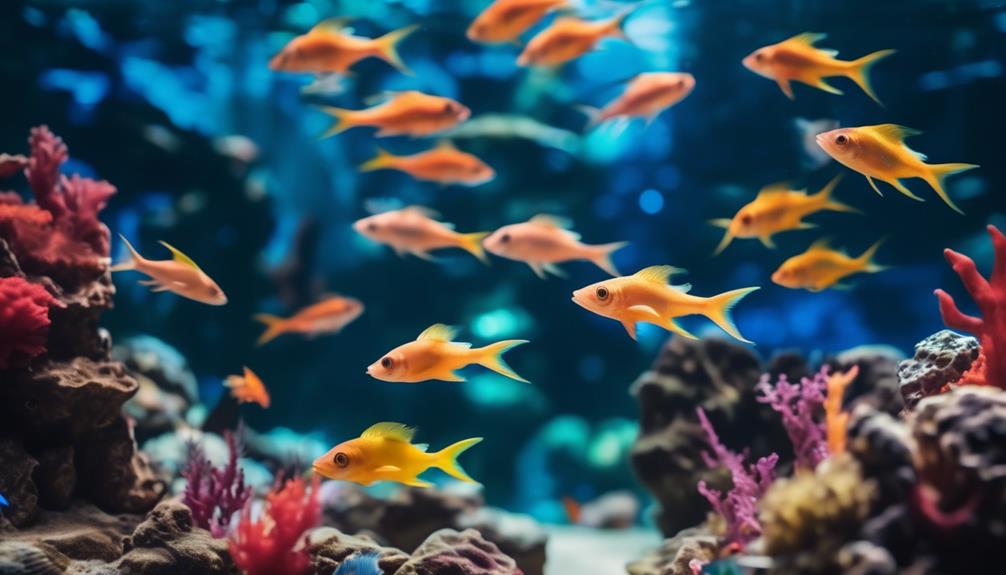
A medium to large aquarium is necessary for keeping goatfish. These fish require ample space to swim and explore, as they’re bottom-dwelling species. A tank size of at least 50 gallons is recommended for a single goatfish, with an additional 20 gallons for each additional fish. This ensures that they’ve enough room to move and establish their territories.
Goatfish are known to be active swimmers, so providing them with a spacious environment is essential for their well-being. It’s also important to consider the tank’s dimensions, as goatfish prefer longer tanks rather than tall ones. This allows them to have more horizontal swimming space, which better suits their natural behavior.
Providing a suitable tank size will promote a healthy and thriving goatfish community in your aquarium.
Weekly Care Tips for Goatfish
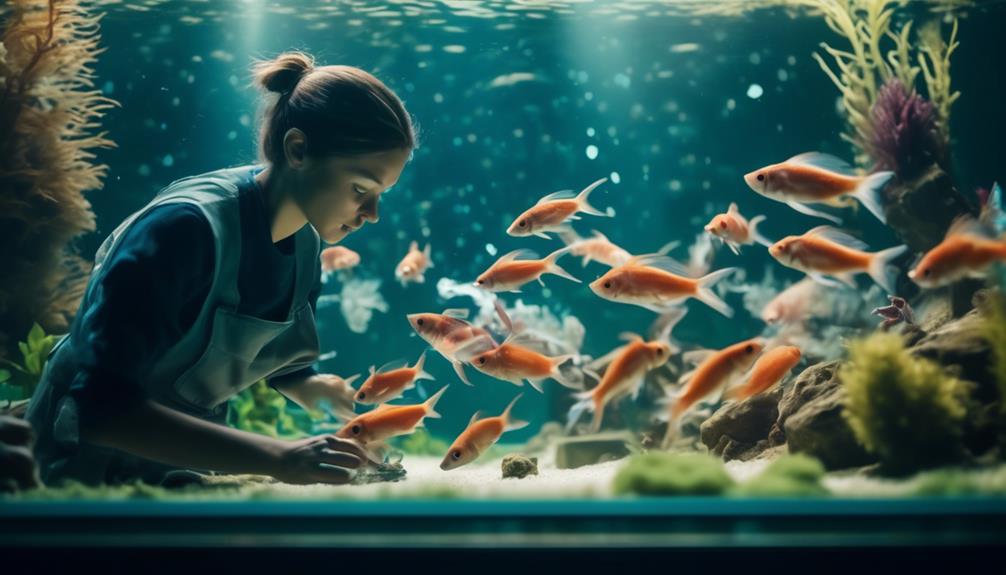
Moving on to the weekly care of your goatfish, it’s important to ensure that you’re providing them with the necessary attention and maintenance to keep them happy and healthy. Here are some care tips to keep in mind:
- Perform regular water changes to maintain water quality and remove any accumulated waste.
- Monitor and maintain appropriate water temperature, which should be within the temperate to tropical range.
- Offer a varied diet of fresh and frozen meaty foods, including small crustaceans and worms.
- Provide hiding places and live rock in the tank to create a comfortable and stimulating environment for your goatfish.
- Keep an eye out for any signs of illness or stress, such as changes in behavior or appetite, and take prompt action if necessary.
Goatfish Compatibility With Other Fish
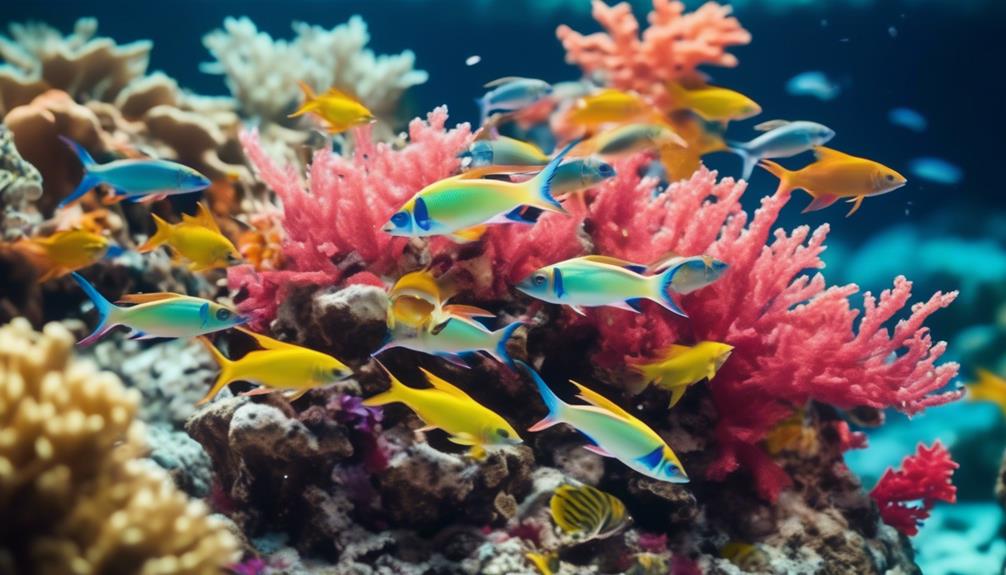
Goatfish are compatible with a variety of other fish species in a saltwater aquarium setting. They are generally non-aggressive and can coexist peacefully with small to medium-sized fish. However, it is important to avoid keeping them with very small fish, as they may become prey. To give you a better understanding, here is a table showcasing some suitable fish species to keep with goatfish in your saltwater tank:
| Compatible Fish Species | Incompatible Fish Species |
|---|---|
| Clownfish | Damsels |
| Gobies | Angelfish |
| Blennies | Triggerfish |
| Wrasse | Lionfish |
Remember that compatibility can vary depending on the specific fish species and their individual personalities. It is always recommended to research and consult with an expert before adding new fish to your goatfish aquarium.
Preferred Water Parameters for Goatfish
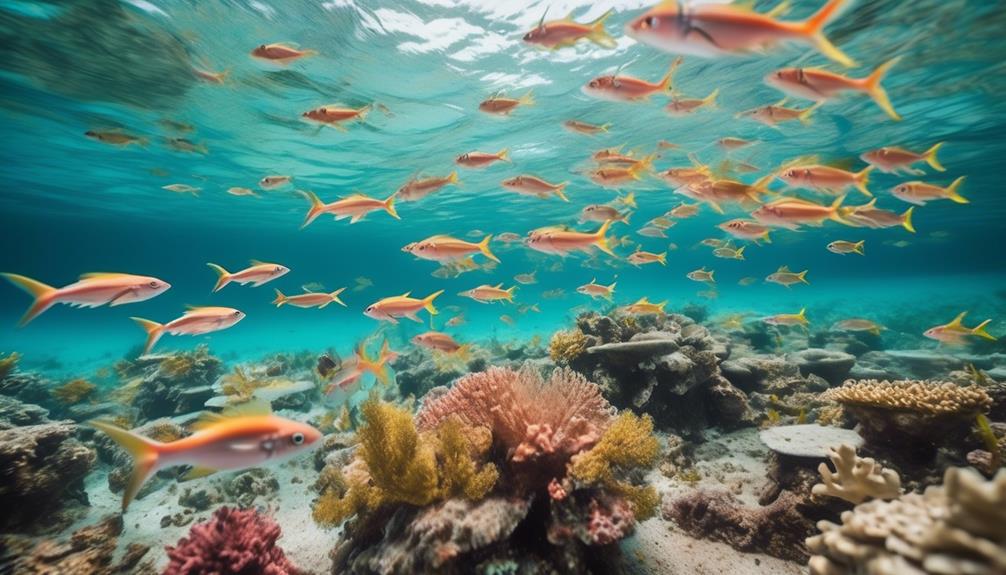
To ensure the optimal care and well-being of your goatfish, it’s essential to maintain the preferred water parameters in your aquarium. Here are the preferred water conditions for goatfish:
- Temperate to tropical water: Goatfish prefer water that’s neither too hot nor too cold.
- Moderate hardness: The water should have a moderate level of hardness to mimic their natural habitat.
- Slightly alkaline pH: Goatfish thrive in water that has a slightly alkaline pH.
- Variety of conditions: While they have specific preferences, goatfish can tolerate a range of water conditions.
- Live rock and hiding places: Goatfish appreciate the presence of live rock and hiding places in their aquarium.
Recommended Diet for Goatfish
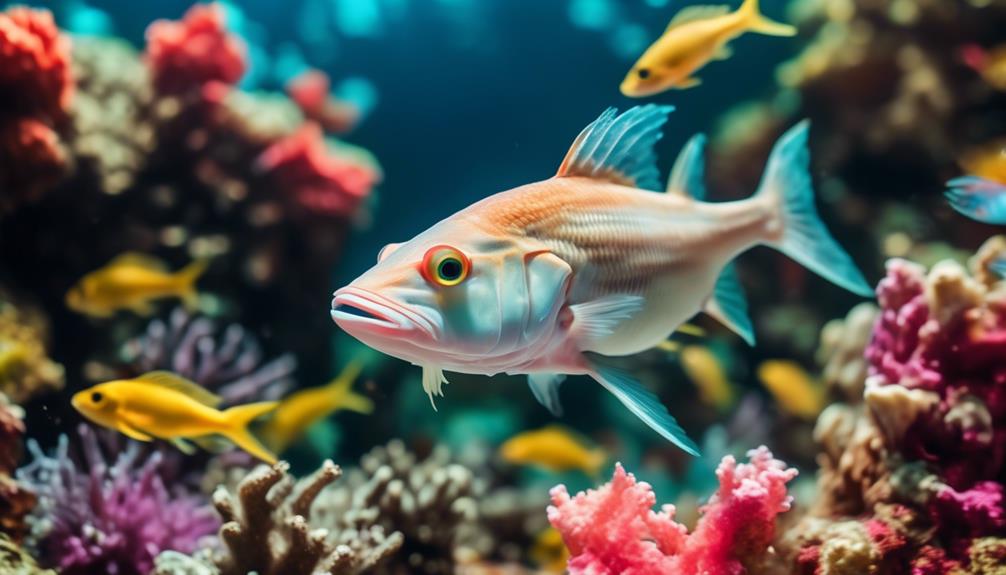
To ensure the health and nutrition of your goatfish, it’s important to provide them with a recommended diet.
Goatfish are benthic feeders, which means they sift through the sandy substrate to find their food. They feed on small crustaceans, worms, insects, and even small fish.
To meet their dietary needs, it’s recommended to offer them a variety of fresh and frozen meaty foods. You can provide them with options like brine shrimp, bloodworms, mysis shrimp, and chopped seafood. Sinking carnivore pellets and granules can also be given to supplement their diet.
It’s important to feed them multiple times a day in small portions to mimic their natural feeding behavior.
Breeding Process of Goatfish
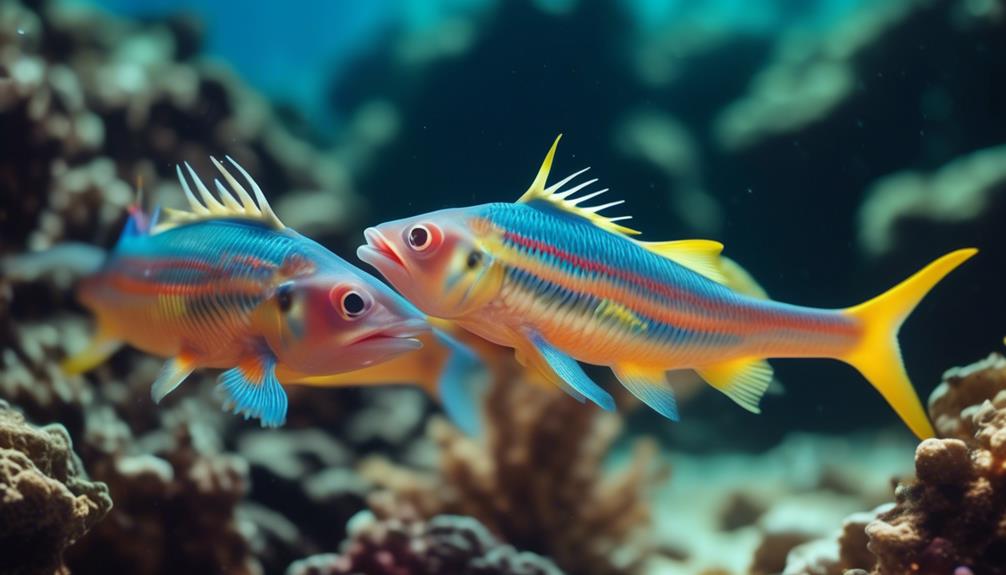
The breeding process of goatfish begins with the release of buoyant eggs into the water. Eggs float freely with the current until they hatch.
The larvae then develop over a period of 4 to 8 weeks. After metamorphosis, they develop barbels, which are sensory organs used for bottom feeding.
The young goatfish start exploring their surroundings and gradually join schools. As they mature, they’re ready to reproduce and continue the cycle.
This unique breeding process allows goatfish to adapt and thrive in their environment. It’s fascinating to see how these fish navigate through different stages of life, from the release of eggs to the development of specialized features for feeding.
Understanding their breeding process sheds light on the intricate life cycle of these captivating creatures.
Care of Goatfish Larvae and Juveniles
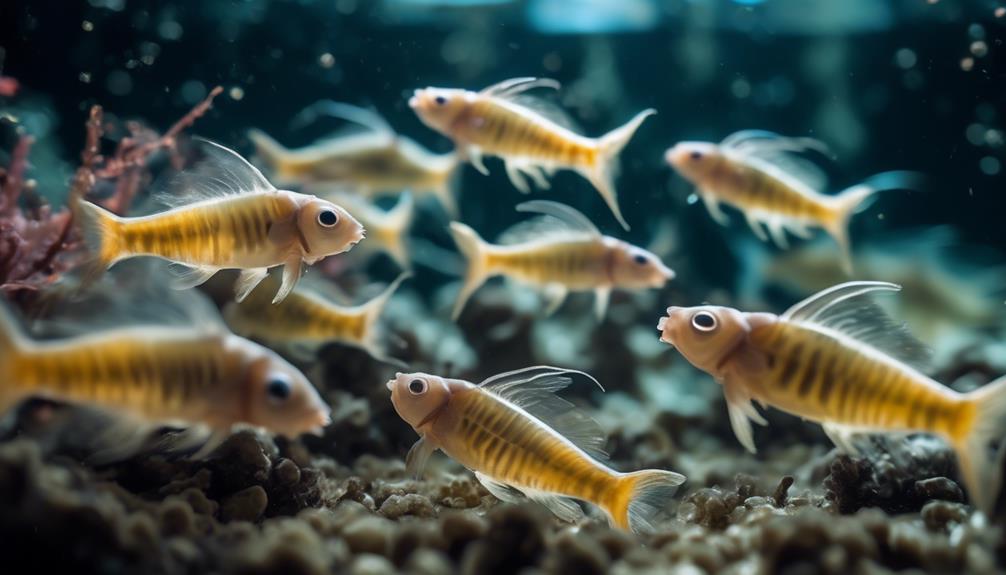
As you care for goatfish larvae and juveniles, it’s important to provide them with a suitable environment and proper nutrition. Create a tank setup that mimics their natural habitat, with sandy substrate, live rock, and hiding places.
Maintain a temperature between 72-78°F and a pH level of 8.1-8.4. Keep the water clean by performing regular water changes and using a good filtration system.
Feed the larvae and juveniles a varied diet consisting of small crustaceans, worms, insects, and small fish. Offer them fresh and frozen meaty foods, as well as sinking carnivore pellets and granules.
Monitor their growth and behavior closely, as any abnormalities may indicate health issues. With proper care and attention, your goatfish larvae and juveniles will thrive and grow into healthy adults.
Frequently Asked Questions
How Often Should I Clean the Tank for My Goatfish?
You should clean the tank for your goatfish at least once a week. Regular maintenance is important to ensure a clean and healthy environment for your fish.
Can Goatfish Be Kept in a Freshwater Aquarium?
No, goatfish cannot be kept in a freshwater aquarium. They prefer temperate to tropical water with slightly alkaline pH and moderate hardness. They are suitable for saltwater tanks and appreciate live rock and hiding places.
Do Goatfish Require a Specific Type of Substrate in Their Tank?
No, goatfish do not require a specific type of substrate in their tank. They are bottom-swimming fish that sift through sandy substrate to feed. They appreciate live rock and hiding places.
Can Goatfish Be Kept With Aggressive Fish Species?
Goatfish should not be kept with aggressive fish species. They are generally non-aggressive and prefer peaceful tankmates. It’s important to consider the compatibility of fish species to maintain a harmonious aquarium environment.
How Long Does It Take for Goatfish Larvae to Develop Their Barbels After Hatching?
After hatching, it takes about 4 to 8 weeks for goatfish larvae to develop their barbels. These barbels help them with bottom feeding. So, it’s a gradual process that takes a bit of time.
What Are the Similarities and Differences Between Goatfish and Batfish Behavior and Breeding?
Goatfish and batfish have some similarities in their behavior, such as being bottom-dwellers and both having a distinct appearance. However, when it comes to breeding, there are significant differences. Goatfish are known to be nest spawners, whereas intelligent batfish species are mouthbrooders, carrying their eggs in their mouth until hatching.
Conclusion
In conclusion, exploring the world of goatfish has been an eye-opening experience. Their unique behavior, preferred habitat, and fascinating breeding habits have provided a deeper understanding of these captivating creatures.
By providing the right water conditions and a varied diet, goatfish can thrive in aquariums. The pelagic spawning process and the development of barbels for bottom feeding add to their intriguing life cycle.
Dive into the world of goatfish and be amazed by their beauty and complexity.




